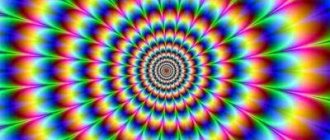Green color: Pixabay Green color is multifaceted and positive, so it fits perfectly into any image. This is proven by style icons Katy Perry, Kim Kardashian and Kylie Jenner. To look no less luxurious, you need to know how to combine green with other tones. Collections of world-famous designers will help you create a fashionable look.
Interesting facts about color perception
This theory was invented by the famous German writer Johann Goethe. The bottom line is that a dark palette has a calming effect, while a light palette has an invigorating effect. If you look at the cold spectrum, you will first notice blue, and when looking at the warm spectrum, yellow. They are the “foundation” for creating all other shades.
As mentioned above, gamma affects people both on a physiological and mental level. In the first case, the interaction should occur in a fairly short period of time, and in the second, a longer one. Perception functions through associations. First we catch it with our visual organs, and then the influence is tactile. For example, blue belongs to the cold complex.
Many scientists believe that it has a direct effect on body temperature or blood pressure. The spectrum from blue to greenish contributes to its increase, and from yellow to reddish - to its decrease.
Leaf color: landscape comes to the fore
During the Renaissance, the color green is found much more often than before in paintings, because the landscape becomes an important element of the picture. During the Early and High Renaissance, with its characteristic anthropocentrism, nature served only as a background for the image of man, who was the center of the Universe. Human figures were invariably located in the foreground - as, for example, in the paintings of Raphael and Leonardo da Vinci.
Raphael. Portrait of Maddalena Doni. 1506.
Leonardo da Vinci. Mona Lisa. 1503.
Venetian artists of the Late Renaissance, first Giorgione
, and then
Titian
, rethink the role of landscape.
“Nature” still serves as a frame for the scenes playing out against its background - but the figures of people no longer occupy a dominant position.
For example, in one of Giorgione’s most mysterious paintings, “The Storm” (researchers offer about 80 different interpretations of the plot), which is sometimes also called “The Thunderstorm,” nature is shown as a pastoral refuge from the world of everyday prose.
Giorgione. Storm. 1508.
The characters are placed alone in different parts of the canvas, and the compositional center of the work is a perspective receding into the distance, a view of the city. Giorgione uses the principle of contrast. The pristine wild idyllic nature serves as a resting place for a traveler who accidentally wanders here (his clothes reveal him to be a fashionable city dweller), who may have come here to find peace among the bushes under the canopy of trees.
What does green mean in psychology?
A huge amount of this tone in nature is associated with the presence of chlorophyll. This is a special pigment contained in the leaves and stems of many representatives of the flora. It allows plants to independently produce nutrients to support their vital functions: this particle is an important link in a process such as photosynthesis.
Green is obtained by combining yellow and blue, so it can be interpreted in different ways. On the one hand, it is recognized as the safest in the world. It is not for nothing that such a signal at a traffic light allows you to cross the roadway. On the other hand, it is a sign of life, harmony and tranquility. Anyone who looks at this tone will associate it with growth and development.
The color of the Russian land
In the history of Russian painting, Alexei Savrasov
. He was the first to turn away from the “italized nature” that was imposed on young students at the Imperial Academy, and began to paint “native” landscapes. Mostly these were images of early spring, melting snow, nature not yet waking up after a long winter, as in the famous painting “The Rooks Have Arrived.”
Alexey Savrasov. The Rooks Have Arrived. 1871.
This topic was almost innovative in the domestic landscape school. Many masters believed that making Russian cold the subject of an image was bad form, and Karl Bryullov said: “No matter how you paint winter, spilled milk will come out.”
Therefore, before, artists only painted summer landscapes with “Italian” landscapes. But Savrasov did not limit himself to the theme of the early Russian spring. He wanted to update summer images, make them recognizable, and give them a national flavor. As a result, such films as “Rainbow” and “Country Road” appeared.
Alexey Savrasov. Rainbow. 1875.
The artist uses his favorite technique and accurately conveys the feeling of freshness after the rain. Puddles of dirty water can be seen everywhere, but in contrast with the color of the earth, the emerald mossy green looks especially bright. Thanks to this contrast, even a washed-out country road looks almost festive, as if nature itself is rejoicing at the end of the rain.
Alexey Savrasov. Country road. 1873.
However, there were not many joys in the life of the artist himself: there was not enough money from the sale of paintings, his wife and children left him, he began to drink and eventually died in a hospital for the poor, abandoned and forgotten by everyone.
Characteristic
All cultures and nationalities have come to the general conclusion that it is a connotation of prosperity. This meaning in our subconscious is associated with the awakening of nature in the spring, when the snowdrifts melt and young grass appears, the leaves of the trees bloom and everything around seems to come to life. Numerous religious festivals and traditions originate from this performance.
Some believe it is the gamma of life force. She is able to replenish the lack of energy at the psycho-emotional level. Varieties with a large drop of blue have a calming effect. This cold type is often used in the treatment of phobias, such as fear of enclosed spaces. Individuals with claustrophobia suggest spending some time in a room where the walls are painted a soft greenish color. According to experiments, such an atmosphere makes it much easier to cope with the condition that arises in a closed room.
Polls say
Currently, the favorite color of Europeans is blue (40 percent of residents prefer it). The “rating” of green is 17 percent, red is 12 percent, yellow is 6 percent, orange is 5 percent. The remaining percentages come from shades of these colors, as well as white and gray.
Like long echoes that mix in the distance and there merge into a dark, deep unity, spacious as night and like light - like long echoes, fragrances, colors, and sounds answer one another. Charles Baudelaire
What does the color green symbolize in psychology?
It has long been considered a symbol of happiness and joy, harmony and peace, good luck and prosperity, as well as balance and wisdom. In past eras, the hue was associated with activities such as farming and gardening.
In the Orthodox religion, the palette is known as a sign of immortality, and in Islam it is the embodiment of heaven and life. Tone is very important in Ireland. Everyone knows that this is the centerpiece of St. Patrick's Day. And the leprechaun here is always depicted in clothes made in greenery.
I have found that it has a particularly beneficial effect on people who are under stress or nervous tension. In this case, it calms the central nervous system and helps you feel in harmony with reality. But despite all the advantages, several centuries ago in some regions the shade had negative symbolism. For example, women with green eyes were a priori considered witches. He was also associated with various evil spirits: demons, merman.
Psychologist Daria Milai
Make an appointment
The color of youth and the image of heaven on earth
The main enemies of the Romans - the barbarians (aka Germans) - were able to raise the rating of green, and at the same time blue. After their massive invasions of the empire in the 5th century, new colors came into fashion. For a long time, these shades were inferior to red, yellow and white, were not considered noble and were perceived as savage - even slaves were ashamed to wear such clothes. But thanks to lovers of extravagant costumes, the meaning of the color green, which first appears in women’s wardrobes, has gradually changed.
In the 14th–15th centuries, paint that was once unpopular among artists was already actively used by miniaturists. In their drawings, for example, we can see a green floor in the royal castle, although in reality it was not like that. The emerald color in this case is the artist’s invention.
Simon de Esden presents his book to King Charles V of France. Book I, Sayings of the Romans and Other Nations. Last quarter of the 15th century. Source
Green evokes strong associations with a blooming garden, which in the medieval mind was perceived as an image of heaven on earth. It allowed us to speculatively approach Divine perfection, lost due to the sinful essence of man. Therefore, the green interiors in the royal chambers are filled with symbolic meaning and serve as a metaphor for righteous reign.
Christ among teachers. Rouen Book of Hours. 1465. Source
Maidens and youths in medieval miniatures are also often dressed in green clothes, which in this case is interpreted as a sign of youth, passion and love. Youth is like fresh leaves on a tree that have barely emerged and fruits that have not yet ripened.
Courtyard of love. Edward IV and his wife Elizabeth Woodville. Collection of poems by Charles D'Orléans. Until 1483. Source
Pleasure Garden. A novel about a rose. 1487–1495.
In religious scenes, green is used as one of the attributes of the image of the Garden of Eden - the Kingdom of God. This color in icon painting symbolizes the victory of life over death, and most often it can be found in scenes of the Nativity of Christ.
Nativity of Christ with the Adoration of the Magi. XVIII - early XX centuries.
The robes of saints and martyrs are also depicted in green - as a sign that their good deeds help the seeds of virtue to sprout on earth.
Saints Boris and Gleb. 2nd quarter of the 14th century.
And in the Orthodox tradition you can also see green heads of churches - as a rule, churches dedicated to the martyr or the Trinity were depicted this way. In the latter case, this color is formed by the fusion of yellow, associated with the Holy Spirit, and blue, the symbol of God the Son, Jesus Christ.
Associations
The main interpretation that appears in anyone’s head is the foliage of trees and flowers, berries, fruits, plants. You can often find birds, reptiles and amphibians that have a greenish color: crocodiles, frogs, parrots, organists.
Psychologists treat different shades differently. For example, light green is associated not only with greenery, but also with yellowness, so it can be interpreted in either direction. But if there is not too much green in it, then it is classified as cool in the spectrum and is credited with calming properties.
Usually this tone is considered to be more positive, including its dark varieties. Indeed, in all its manifestations it is closely connected with nature, which people see every day.
The color that enlivens the face of a saint
If in the Middle Ages green was the color of magical potions, then the Early Renaissance artist Duccio
was able to literally turn it into an elixir of youth - albeit of a limited duration. To paint a face (he worked exclusively with religious subjects), this master created a green “substrate”, on top of which he applied pink, which is why the images seemed almost alive to his contemporaries. But over the years, the “upper” color faded, and today all the faces created by Duccio, on the contrary, look deathly pale.
Duccio. Madonna with angels. 1300–1305. Source
Duccio. Annunciation. 1308–1311. Source
Impact on humans
As noted earlier, any gamma, one way or another, affects not only the emotional background, but even the health of individuals. Therefore, the choice of clothing and interior design must be approached with great responsibility, since all these elements will be evident every day.
In my personal consultation, I will tell you how to use shades correctly to get rid of anxiety and find peace. For now, let's look at the main aspects of this impact.
Positive effect
If we talk about lovers of greenery, they are distinguished by charm, stable psyche, perseverance, courage and truthfulness. I believe that such people tend to be objective, since they see not only the good, but also the bad. This skill allows them to look at things soberly, assess their own capabilities and the consequences of the situation. Thanks to this, their decision carries great weight, and the ability to make correct calculations makes them an authority among others.
Greenish is a sign of growth and development. This means that individuals who prefer this tone are constantly striving to learn new things and improve. Among other things, fans are characterized by stability, kindness and the ability to be compassionate.
Negative effect
But there are also negative qualities in the character of green lovers. Green color in human psychology means peace, which can lead to apathy for those who spend a long time in a room with such a palette. The absence of desires is explained by the fact that in such an atmosphere the individual makes up for the lack of energy and receives special energy support.
Face-to-face consultation
What are the features and advantages of face-to-face consultation?
Find out more
Skype consultation
What are the features and benefits of Skype consultations?
Find out more
The natural shade conceals all the secrets of the universe, and therefore endows people with secrecy. The quality is more bad than good. I use gamma for my own purposes. With its help, they cure claustrophobia by placing someone who suffers from a fear of closed spaces in a room made in greenish tones. The calming aura has a beneficial effect on the body, which helps to significantly reduce attacks.
Also, you should not resort to greens when you are overworked or nervously exhausted, as this can lead to a complete loss of energy. But in general, the effect depends on the balance of yellowness and blueness. If blue predominates, the shade will become more intense. And in the case of yellow – harmonious and invigorating.
Color of Lost Paradise
After Poussin, landscape painters painted nature for a long time without leaving the studio: the theory of color plans became a canon for all art academies.
The first to break with this tradition was the English painter John Constable.
. He worked a lot in the open air and even tried to complete paintings in the open air. At that time, such experiments seemed outright eccentricity: compact metal tubes for paint with a screw cap that could be taken with you would appear only in the second half of the 19th century.
Constable's landscapes were thematically different from the work of his contemporaries. The artist introduced everyday life into painting, depicting puddles, unsightly banks of reservoirs, grazing cows, and old barns on his canvases.
The so-called village landscape was completely unpopular with viewers at that time. In order for his paintings to be included in the exhibition, Constable - apparently to give them greater significance - chose gigantic formats. For example, “White Horse by the Pond” reached two meters in width. But even this decision did not save its author from caustic criticism.
John Constable. White horse by the pond. 1819.
In Britain he was not appreciated for a long time, but on the other side of the English Channel, Constable’s works became popular during the artist’s lifetime. Having once seen his painting “Hay Wagon,” the French painter Theodore Gericault convinced his art dealer to buy several paintings by the English landscape painter at once.
John Constable. Hay cart. 1821.
At the beginning of the 19th century, the English countryside was no longer as harmonious as the artist showed it. Industrialization and the industrial revolution primarily affected the outskirts: people began to use machines on farms, replacing human labor with them, as a result, many lost their jobs and were forced to go to the city. But for Constable, the clean air of the village and the endless green meadows became an image of a lost paradise.
Impact on mental state
In a general sense, green is known to be relaxing. But if we talk about varieties, for example, light green, then it can have a slight invigorating effect.
Let's look at how it affects your well-being:
- Color has a beneficial effect on the psyche. It allows you to overcome problems such as phobias, neuroses, melancholy and anxiety. This is especially important for hot-tempered individuals, as greens help to “cool them down.” And for those who feel overwhelmed and empty, it gives strength, gives a good mood, and also increases productivity and concentration.
- Individuals who spend a long time in a room where the walls are painted in a similar color scheme feel comfort and coziness. Even a small amount of green decor can improve the condition of the body.
- For people with mental illnesses and frequent mood swings, the tone allows them to get rid of negativity.
- Color therapists are confident that it reduces pain, and also stimulates the rapid treatment of infectious and inflammatory diseases, stabilizes blood pressure and heartbeat. There is a huge impact on the visual and respiratory organs, bones, muscles and gastrointestinal tract.
- It is believed that it has a beneficial effect on relationships, helping lovers to be more caring and attentive.
Men
Men who prefer green are usually very sympathetic and kind. They will help those in need even to their own detriment. They are accustomed to taking responsibility for caring for loved ones, as they consider it their task to make the family happy. By nature, people are intelligent and reasonable. It cannot be said that they are guided solely by reason, but at least they can find a middle ground between emotions and common sense. They are not prone to aggression and are not quick-tempered. It is extremely difficult to piss them off. Attentive to details, neat. If they set a goal for themselves, they will do everything possible and impossible to achieve it. They don’t like empty chatter, but they will never refuse to chat with an interesting, intelligent interlocutor.
Use in advertising
Since the palette is associated with safety and freshness, it can often be found on packaging with natural and organic products. The marks “eco” or “bio” are also accompanied by this shade.
The method is used if the contents of the box contain fruits or vegetables, for example, apples, kiwis, cucumbers. The technique is also excellent for advertising medical products, and can also be seen in the logos of private clinics, pharmacies and other health-related companies.
The color of emptiness and loneliness
During the war, many artists experienced a creative pause: some took part in battles, but those who remained in the rear could not think about painting. However, the American Edward Hopper
continued to draw his strange images, permeated with a feeling of loneliness.
He was a very reserved person and sought to distance himself from people, protecting his own life from unnecessary events. In his work, the artist also never showed dynamics, preferring the effect of a frozen frame.
The heroes of his works “Morning Sun”, “Soft Car” and “Night Owls” are impersonal city residents, as if imprisoned in a glass prison.
Edward Hopper. Soft carriage. 1965.
To convey a sense of alienation, Hopper resorts to the image of the aquarium in which his characters live - literally, as in Night Owls, or metaphorically, as in Morning Sun.
Edward Hopper. Morning sun. 1952.
The artist actively uses a light green tint, creating cold lighting. It emphasizes the artificiality of the setting, as if everything the viewer sees is just decoration. The inertia of the environment is also transmitted to the characters, for whom any communication is impossible. Researchers call Hopper's works “metaphors of silence.”
Edward Hopper. Night owls. 1942.
What does green color in clothes mean?
The priority of a specific color scheme in outfits can also tell a lot about a person. After all, it is believed that through such preferences a person shares his mood, experiences, or unconsciously indicates character traits.
- Lovers of delicate greenery are characterized as easy-going and pleasant individuals to communicate with. They tend to communicate and collaborate with others.
- A bright option, especially in combination with yellow or orange, symbolizes physical activity and positivity. This complex always lifts your spirits and gives you a burst of energy for the whole day. That is why the outfit is used in order to reveal your potential.
- The meaning of dark green in psychology comes down to calm and harmony. People who prefer this type are characterized by some isolation and detachment. They love to be alone, to retire from others and immerse themselves in their own inner world.
Interesting fact: the famous empresses of the Russian Empire - Catherine de Medici and Elizaveta Petrovna - were crazy about greenery. Their choice indicates masculinity of character. In any case, absolutely everyone can afford such a wardrobe, regardless of appearance. It is suitable for both special occasions and everyday life.
The color of new bioart
Today, the color green is associated with one of the most scandalous and dubious works of art - the creation of the Brazilian-American artist Eduard Katz
, who stood at the origins of bioart. Preferring modern laboratories to classical workshops, he likes to perform very unusual experiments on his models.
In 2000, Katz teamed up with a French biologist and modified the rabbit's genetic profile to include a foreign compound, green fluorescent protein (GFP), found in a bioluminescent jellyfish. This gene is responsible for the neon glow of the body in the ultraviolet range.
The female rabbit with FPD was named Alba, and if blue rays were directed at her, she began to glow green.
Eduard Katz. A female rabbit with PPF. 2000.
Spectators at the Avignon Festival who saw Katz’s “work” were pretty scared and shocked. Many accused the artist of cruel and irresponsible treatment of the unfortunate animal. Katz himself explained the meaning of his “creation” this way: “We have entered a new era. A new art is required. It doesn't make sense to use paints the same way they were used in caves."
Katz's outrageous work is a cynical metaphor showing how a new element can influence the further evolution of art. And despite the repulsive form in which this thesis was presented, it is difficult to disagree with it.
Who chooses green?
About 15% of people prefer greenish shades. And approximately the same number have dislike for him due to superstitions. There is a connection between color taste and character. But don't take it too seriously. After all, each person is unique, so you can get to know her well only through close communication, and not with the help of generalized descriptions.
Ask a question
However, male admirers have qualities such as:
- Kindness. They are friendly, and their face is often decorated with a smile. They always try to help others, even if it is to their detriment. This is due to the fact that their level of empathy is quite high.
- Equilibrium. It is difficult to provoke such individuals to display negative emotions, since they know how to control themselves in almost any situation. Hot temper or aggression are definitely not characteristic of them.
- Perseverance and accuracy. Of course, they are far from perfectionists, but they strive for this. This manifests itself in excessive attention to detail, persistence in achieving goals and excellent productivity.
- Caring. These are excellent spouses and fathers. They strive to ensure that their loved ones are happy and do everything possible for this.
- Sociability. This trait is not as strong as those who prefer yellow or reddish, but they love good conversations.
Female representatives who love greenish shades often prioritize family rather than work. They love to expand their circle of acquaintances, have goodwill, and good health. In addition, green color in a woman’s psychology means that she:
- Patient. Like men, she knows how to control her own emotions. It is unlikely that such girls will throw tantrums and demonstrate sudden mood swings.
- Empathic. The ability to understand the feelings of others makes her provide support to people. She knows how to give excellent advice on time and find the right words.
- Intelligence. She is always smiling, respects other people and will not cause them discomfort unless there is a good reason for it.
In addition, such individuals have prudence and balance between the emotional component and reason.
The color of dreams and escapism
Following the realists, the next generation of artists—the symbolists—turned to landscape. But they were no longer interested in living nature, but in the world of dreams: they wanted to tell what paradise could look like.
Pierre Puvis de Chavannes saw beauty in images filled with melancholy and quiet melancholy. The artist’s faded chalk palette is dominated by ghostly figures, which is why all his works are covered in a flair of mystical timelessness.
For example, the painting “Between Art and Nature” depicts everything that Chavannes loves so much: many models in frozen poses, among which there is the Mother of God, the Pieta, and just a beautiful Virgin, a ceramicist with a bunch of finished products and a couple of archaeologists. The artists themselves stand a little apart from the general group and contemplate what is happening. Before us is an allegory of creative activity: it takes a person away from reality into a world transformed by creative vision.
Pierre Puvis de Chavannes. Between art and nature. 1888. Source
Symbolist Chavannes deliberately used pastel colors to make the painting somewhat “aging” - as if we were looking at an ancient myth embodied in colors. At the same time, the landscapes that he chose for his works were quite modern: the plains of Picardy, the outskirts of Marseille, or his favorite places in the Bois de Boulogne.
Many artists fell in love with the work of Pierre Puvis de Chavannes: Gauguin took reproductions of his works with him to the islands, Rodin considered his compatriot the best painter, and the Russian master Mikhail Nesterov, during his Paris trip, admired the frescoes he painted in the Pantheon.
One of Chavannes's most loyal fans was the symbolist Viktor Borisov-Musatov
. He even wanted to go to his idol as a student, but, alas, he decided that he was too old to teach classes and closed his workshop. However, this did not stop Borisov-Musatov. Following Chavannes, he began to work in pastel colors, abandoned oil and painted everything with tempera, as the Early Renaissance masters, beloved by the Frenchman himself, did.
In many of his works, Borisov-Musatov also sought to generalize, avoiding plot and showing the beauty of a person living in harmony with nature. His landscape is always an emerald color, which the viewer would never see in a natural environment.
Borisov-Musatov himself considered one of these paintings to be a kind of response to the work of Puvis de Chavannes.
Victor Borisov-Musatov. Emerald necklace. 1903–1904.
Despite the title of the painting, even an attentive viewer will not find an emerald necklace in it. The girls themselves appear in the form of precious stones, personifying harmony and femininity. But if the artist had depicted them in the interior of the room, he would not have been able to achieve the same effect. Borisov-Musatov considered his heroines an integral part of nature, its continuation, so he made their frame emerald - a landscape background, and not the fluffy skirts of beauties (which, by the way, were already considered old-fashioned at the beginning of the twentieth century). The master himself explained his idea this way: “Women in crinolines are less sensual, more feminine and more like bushes and trees.”
Who is it suitable for?
This is a universal shade that, if combined correctly, will be appropriate for both a party and an everyday look. However, stylists do not recommend wearing bright light green outfits to important meetings or negotiations, as there is a risk of giving the impression of a frivolous person.
The designation of green color in the interior comes down to spiritual comfort. It will be especially pleasant for those who value warmth and want to feel maximum comfort at home. Therefore, the gamma is suitable for bedroom design, which will contribute to deep relaxation and excellent rest. The most attractive combinations will be with black, orange, brownish, and yellow.
The color of witches and witchcraft potions
But at the end of the Middle Ages, the attitude towards green changes again: it turns into a symbol of evil, it is used to depict dragons, witches, all kinds of poisons and other abominations.
Witches who conspired with a demon. Chronicles of Pilgrimage. Second quarter of the 15th century. Source
Researcher Michel Pastoureau notes that the dragon in medieval culture is not a fantastic, but a very real creature, and in no bestiary it is not associated with black - only with green.
Alexander the Great fights two-headed, eight-legged crowned dragons. The True Story of Good King Alexander. 1420–1425. Source
Another creature that struck terror into medieval man was the frog: people believed that, like a snake, it was capable of spewing poison. Her entrails and swamp-colored body were used as ingredients for witchcraft potions, and for this reason all witches were attributed green eyes, which have long been considered a sign of debauchery and perverted nature.
A satanic dragon with a human head, representing the papacy of Urban VI, whose election was disputed and led to the appointment of antipope Clement VII. Book of predictions of the Popes. 2nd quarter of the 15th century. Source
Symbolism of white color
Color-border, “non-color” (nothing or something before any beginning), daylight. White is the sum of all light. In the atmosphere it is the sum of colors, and its decomposition produces a rainbow. White is a symbol of purity, innocence, and naturalness. It emphasizes the idealism of character and the desire for perfection. This is the color of eternity and deities. Sufis (Islamic ascetics) associate the color white with the secret of inner light.
If you are dressed in all white from head to toe, then be careful not to look too “hospital” or create the impression of emptiness and infinity. White is often associated with absence, with something non-existent (“white crow”, “white spots”, “white ticket”...). It seems to symbolize anticipation: wedding, baptism, and so on. Reluctance to give up white in clothing may indicate a fear of leaving adolescence.
Shades of green
There are many shades of green, each of which has its own separate meaning. For example, people who love its dark shades value stability most of all in life. And those who appreciate pale tones have a calm disposition. Light green is used in color therapy to improve vision.
Turquoise (blue-green) is a cool shade, symbolizing freshness, coolness, and purity. Individuals who love turquoise tones have a timid character. Dark turquoise - not recommended for people with nervous exhaustion. Associated with cruelty and a tendency to isolate. People who are drawn to this shade are overly demanding of themselves, have a principled character and almost always achieve their goals. Brown-green - consists of four shades: yellow, black, green and red. Individuals who prefer khaki color attach great importance to pleasure, love relaxation and entertainment. Yellow-green - people who like this shade have many friends, strive to make as many acquaintances as possible, and love novelty.
Peculiarities of perception
As mentioned above, every shade perceived by a person affects his psyche. In general, green is the color of relaxation and calm. Its soft shades are used in color therapy to relieve stress, nervous tension, emotional exhaustion and anxiety. Bright variations of green can energize, stimulate performance, improve mood and increase vitality.
- Color improves sleep . If a child has difficulty falling asleep or sleeps restlessly, it is worth providing green lighting in his room. Color also improves the process of falling asleep in adults. It is enough to hang light green curtains in the bedroom or paint the walls in a calm tone of this range.
- Green colors have a positive effect on the nervous system. Color encourages positive thinking and helps overcome phobias and anxiety. Often the walls of the offices of child and adult psychologists and psychotherapists are painted in this shade. And also shades of green are often used in the design of corridors and wards of medical institutions.
- For men and women who tend to be hot-tempered and emotionally unstable, contemplating shades of green is also very beneficial. Meditation on this color calms the nervous system and relieves overexcitement. By surrounding themselves with green tones, hot-tempered people over time begin to better control their emotions and behavior.
- In an interior decorated with green tones, a person subconsciously relaxes, feels comfortable and protected. Even a few objects or details in green shades can add orderliness and a sense of comfort to the overall atmosphere of the room.
- In color therapy, this range is successfully used to relieve pain of various types and localizations. Green shades have a regulating effect on the functioning of the heart and help stabilize blood pressure in hypertension. They stimulate the body's defenses, helping it fight colds and viruses.
- Contemplation of green has a healing effect on the organs of vision. If you work at a computer for a long time or have eye strain, doctors recommend looking at a green object for several minutes. And in the summer, it’s best to go to the window and look at the natural greenery for a while.
Symbolism of gray
A moderate color, between black and white, everything and nothing. Gray matter is the brain. “Exercise your gray matter” in colloquial language means to think. “Gray life” is a life without bright events. The color embodies passivity. It is a symbol of respect, indifference, modesty, indecisiveness and neutrality.
In professional life, it reflects seriousness and efficiency when combined with the other. If you wear only gray, it will evoke sadness, fear, the approach of death, cold, monotony, and make you think about worse times. A person wearing gray is, as it were, erased in his own shadow: gray and shadow are identified.
Symbolism of red
Submission, competition, seduction, efficiency, reliability - this is what this color is associated with. Red neutralizes fatigue, stimulates, tones; is the color of vital energy. Red coloring is a symbol of ardent beauty, impulsive strength, youth and health. A lush (mature) red color with a note of violet (purple) is a sign of power.
The color of fire and blood, red is considered the main symbol of life. It speaks of passion, energy, sexuality... power, courage, optimism, ambition. Red neutralizes fatigue and stimulates. Tones; is the color of vital energy. In China and Japan, red is considered an auspicious color, it gives life and protects against evil spirits, so it can be seen on the gates of Shinto shrines, on the entrance doors of houses and on the palanquins of newlyweds.
A red ribbon around the wrist brings good luck and protects against evil spirits. Stones: ruby, garnet. This is the color of the 1st chakra, associated with our roots, our attraction to the Earth.
Symbolism of yellow
Yellow is the color of positive energy. It stimulates the ability to concentrate, enhances the gift of communication, and gives a feeling of lightness. This is the color of the sun, soothing warmth. Symbolizes spiritual light, knowledge, science, dynamism, hopes of youthful forces, as well as intellectual qualities, insight, cheerful disposition and freedom.
In Egyptian mythology, the heat and rays of the sun were considered the golden seed of the god Ra. In Islam, yellow is the color of betrayal and disappointment. Gold is the metal of Christianity. The color yellow is present on the Vatican City flag. Stones: sunstone (heliolite), tiger's eye. This is the color of the 3rd chakra: a symbol of self-respect, self-confidence, power, authority.
The meaning of green for women
Psychologists have found that if a woman chooses any shades of green, then she is subconsciously tuned in to her family and loved ones. This is what is her priority, and not career growth or fulfilling selfish needs. These women are different:
- calm temperament;
- good nature, kindness;
- softness and pliability;
- kindness.
Lovers of the herbal shade are prone to empathy: they feel the emotional state of others. They have good mental and physical health. Most women who prefer a green tint choose the profession of a psychologist or psychotherapist.
Politeness is another characteristic of people who choose herbal shades. Lack of rudeness and assertiveness. These people will never respond with rudeness to rudeness, or with evil for evil. They are peacemakers by nature, born volunteers and rescuers. There is always a friendly smile and good nature on their faces.
They will never make a scandal or throw a tantrum. Patience is their special character trait. They do not have mood swings; they have a smooth emotional background with a tendency toward optimism. These women have one more property - the ability to provide psychological support at the right time. They will always find the right words and be able to console a person in grief.
Symbolism of orange
Orange symbolizes the point of creation and sexuality. It is halfway between red and yellow, that is, between reason and temperament. Orange color accumulates energy and allows you to achieve your goal. Active, tonic, it awakens the senses, symbolizing vitality, enthusiasm, hospitality, sociability, dynamism, joy and carelessness.
It also symbolizes devotion, the art of adaptability, and creative energy. Orange color enlivens the senses and evokes a feeling of comfort and good mood; symbolizes the manifestation of universal Love. Stones: carnelian, amber. This is the color of the 2nd chakra, associated with creative power, inspiration, a sense of beauty, knowledge.
Negative impact
Can the color green harm the human psyche? This shade is not suitable for those who are different:
- increased anxiety;
- isolation;
- the desire not to attract everyone's attention;
- inability to overcome difficulties and obstacles.
Such people prefer to live in their own world, closed from the prying eyes of strangers. They do not like social events and try to communicate with the outside world as little as possible.
Important! The green tint cannot be used to treat mental exhaustion; it will lead to a total loss of vitality.
If you uncontrollably use green shades to relieve stress, then as a result a person will feel complete indifference and may even lose interest in life.
Symbolism of pink
Pink is a very positive color, symbolizing seduction, purity, and devotion. This is a symbol of femininity and love.
This color also has an aspect indicating relaxation and can symbolize the joy of life, a period of success. See life in pink: be joyful, look optimistically into the future. Pink color is romanticism, modesty, timidity, gentleness. It is an emblem of the divine, associated with Venus. This is a symbol of tenderness and delicacy.
Pink color expresses sympathy, responsiveness, but also the search for safety, affection, protection. Writer Barbara Cartland preferred to wear pink clothes, put on pink makeup, use pink objects in everyday life, and so on. Pink was her thing! She achieved success in literature, but was also known for her eccentric gait. She always wore airy pastel pink and caramel pink suits.
Color looks brilliant only in a certain environment, just as eyes only smile on a face. Ludwig Wittgenstein, philosopher











